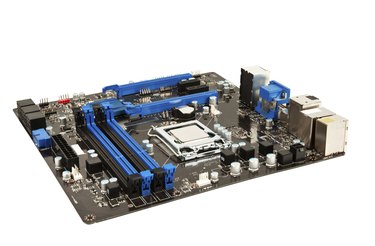
Changing your computer's primary display adapter can be as easy as moving a cable; however, advanced configurations require behind the scenes tinkering. Display adapters handle graphics and video processing. Display adapter is just one acceptable name for the component: graphics card, video adapter, graphics and video card are all synonymous. The primary display adapter designation is important when the motherboard has multiple video devices: When there's only one video device it's automatically the primary display adapter.
Using Autodetect
Video of the Day
Step 1
Shut down the computer. Rebooting will not give you enough time to complete the process.
Video of the Day
Step 2
Disconnect the monitor cable or cables from the current graphics card's video ports. You can identify the display ports based on cable type: they use VGA, DVI, HDMI and DisplayPort.
Step 3
Connect the monitor cable or cables to the desired graphics card's video ports to switch the display adapter. You may have to switch monitor cables or use a converter, if the second display adapter uses different port types.
Step 4
Power on the computer. The monitor will display the boot screen if done correctly.
Using BIOS or UEFI
Step 1
Boot to BIOS or UEFI to access the hardware configuration. If you computer came with Windows 8 installed, it is running UEFI. To reboot into UEFI, open the Charms bar, search for "UEFI," select "Settings," choose "Advanced Startup Options" and click "Restart now" under the "Advanced Startup" menu. Otherwise, press the "Setup" key -- usually "F1," "F2," "DEL," "ESC," or "F10 -- during the boot splash screen to enter BIOS.
Step 2
Locate the "primary display adapter" setting in BIOS/UEFI and change it to the desired display adapter. BIOS features, setting locations and naming conventions vary from computer to computer. The setting will feature a combination of the words display, adapter, graphics, card, video, board, integrated, device and controller. Alternatively, you can switch from built-in graphics to expansion card graphics by setting "Integrated Graphics Device" to "Always Disable."
Step 3
Save and exit BIOS/UEFI. If you don't save, the setting will not change.
- PC Magazine Encyclopedia: Definition of: Display Adapter
- PC Magazine Encyclopedia: Definition of: Multi-GPU
- Toshiba Windows 8 & 8.1 Knowledge Base: How to: Enter the System BIOS or UEFI in Windows 8
- HP Consumer Support: BIOS Setup Information and Menu Options
- Intel Desktop Boards: BIOS Settings Glossary